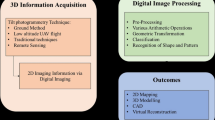Abstract
With the development of remote sensing and images techniques, the oblique aerial photography (OAP), which relies on the unmanned aerial vehicles (UAV), has become increasingly significant, showing advantages of high efficiency, low cost, and high spatial resolution in various disciplines. The OAP technology provides an efficient method for the acquisition of spatial information, site surveying, and mapping. It can also be applied to improve the scientific process of architectural design and planning. This article, therefore, introduces a methodology using point clouds obtained by the OAP and takes the Mengyuan resort hotel in China as a case to discuss the meaning and possibility of employing the OAP in architectural design. This research process includes five main steps: site investigation, drone route planning, data acquisition, model construction, and the application of 3D models. The design project of the Mengyuan hotel is finally fulfilled based on the built 3D point clouds, which can be a reference for future architectural analysis, planning, and research, combining with multiple spatial and remote sensing methods.
Access this chapter
Tax calculation will be finalised at checkout
Purchases are for personal use only
Similar content being viewed by others
References
García-Pulido LJ, Jaramillo JR, Dorado MIA (2017) Heritage survey and scientific analysis of the watchtowers that defended the last Islamic kingdom in the Iberian Peninsula (thirteen to fifteenth century). Int Arch Photogramm Remote Sens Spatial Inf Sci XLII-2(W5):259–265
Ivosevic B, Han YG, Kwon O (2017) Calculating coniferous tree coverage using unmanned aerial vehicle photogrammetry. J. Ecol Environ 41(10):1–8
Ivoševic B, Han YG, Cho Y, Kwon O (2015) The use of conservation drones in ecology and wildlife research. J. Ecol. Environ 38(1):113–118
Qu Y, Yang Z, Yao Q (2019) The application of UAV oblique photography technology in architectural design. In: DEStech transactions on engineering and technology research, DEStech Publications, Changsha, China, pp 123–127
Püschel H, Sauerbier M, Eisenbeiss H (2008) A 3D model of Castle Landenberg (CH) from combined photogrammetric processing of terrestrial and UAV-based images. Int Arch Photogramm Remote Sens Spatial Inf Sci 37(B6b):93–98
Aydin CC (2014) Designing building façades for the urban rebuilt environment with integration of digital close-range photogrammetry and geographical information systems. Autom Constr 43:38–48
Aicardi I, Chiabrando F, Grasso N, Lingua AM, Noardo F, Spanò A (2016) UAV photogrammetry with oblique images: first analysis on data acquisition and processing. Int Arch Photogramm Remote Sens Spatial Inf Sci 41:834–842
Kang C, Cheng Y, Wang F, Zong M, Luo J, Lei J (2020) The application of UAV oblique photogrammetry in smart tourism: a case study of Longji terraced scenic SPOT in Guangxi province. Int Arch Photogramm Remote Sens Spat Inf Sci 42:575–580
Liu S, Tong X, Chen J, Liu X, Sun W, Xie H, Ye Z (2016) A linear feature-based approach for the registration of unmanned aerial vehicle remotely sensed images and airborne LiDAR data. Remote Sens 8(2):82
Gupta L, Jain R, Vaszkun G (2015) Survey of important issues in UAV communication networks. IEEE Commun Surv Tutorials 18(2):1123–1152
Maxa JA, Mahmoud MSB, Larrieu N (2016) Joint model-driven design and real experiment-based validation for a secure UAV and HOC network routing protocol. In: Integrated communications navigation and surveillance (ICNS), IEEE, Herdon, USA, pp 1E2–1
Landau M, Van-Delden S (2017) A system architecture for hands-free UAV drone control using intuitive voice commands. In: Proceedings of the companion of the 2017 ACM/IEEE international conference on human-robot interaction, Association for Computing Machinery, Vienna, Austria, pp 181–182
Tisdale J, Ryan A, Zennaro M, Xiao X, Caveney D, Rathinam S, Sengupta R (2006) The software architecture of the Berkeley UAV platform. In: 2006 IEEE conference on computer aided control system design, IEEE, Munich, Germany, pp 1420–1425
Zhou S, Gheisari M (2018) Unmanned aerial system applications in construction: a systematic review. Constr Innov 18:453–468
Lin C, He D, Kumar N, Choo KKR, Vinel A, Huang X (2018) Security and privacy for the internet of drones: challenges and solutions. IEEE Commun Mag 56(1):64–69
Acknowledgements
The project was funded by the China Scholarship Council (CSC), Grant Number: 201708440230.
Author information
Authors and Affiliations
Corresponding author
Editor information
Editors and Affiliations
Rights and permissions
Copyright information
© 2022 The Author(s), under exclusive license to Springer Nature Singapore Pte Ltd.
About this paper
Cite this paper
Lin, G., Sang, K. (2022). Application of UAV-Based Oblique Photography in Architectural Design: The Case of Mengyuan Resort Hotel in Yunnan, China. In: Kang, T., Lee, Y. (eds) Proceedings of 2021 4th International Conference on Civil Engineering and Architecture. Lecture Notes in Civil Engineering, vol 201. Springer, Singapore. https://doi.org/10.1007/978-981-16-6932-3_38
Download citation
DOI: https://doi.org/10.1007/978-981-16-6932-3_38
Published:
Publisher Name: Springer, Singapore
Print ISBN: 978-981-16-6931-6
Online ISBN: 978-981-16-6932-3
eBook Packages: EngineeringEngineering (R0)




